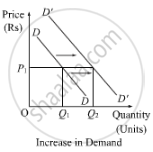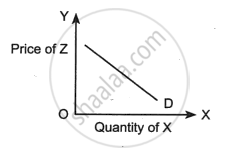Advertisements
Advertisements
प्रश्न
Give reason or explain the following statement.
Increase in demand indicates a rightward shift in the demand curve.
उत्तर
When the demand for a good increases due to a change in the factors other than the price of the good, it is called increase in demand. Graphically, it is shown by a parallel rightward shift of the demand curve.

Parallel rightward shift shows that even at constant prices the quantity demanded of the good rises.
APPEARS IN
संबंधित प्रश्न
| Group 'A' | Group 'B' | ||
| a. | Pen and ink | 1 | Quantity-price |
| b. | Revenue | 2 | Accident |
| c. | Insurable risk | 3 | Transfer income |
| d. | Unemployment allowance | 4 | Short period |
| e. | Reverse repo rate | 5 | Long period |
| 6 | Change in demand | ||
| 7 | Joint demand | ||
| 8 | Quantity * price |
Demand curve and Supply curve.
Define demand. Name the factors affecting market demand.
The demand of a commodity, when measured through the expenditure approach, is inelastic. A fall in its price will result in : (choose the correct alternative)
(a) No change in expenditure on it.
(b) Increase in expenditure on it.
(c) Decrease in expenditure on it.
(d) Anyone of the above.
Explain the problem of what to produce.
Demand for a good is termed inelastic through the expenditure approach when if (choose the correct alternative)
a) Price of good falls, expenditure on it rises
b) Price of the good falls, expenditure in it falls
c) Price of the good falls, expenditure on it remains unchanged
d) Price of the good rises, expenditure in it falls
Distinguish between ‘increase in demand’ and increase in quantity demanded of a good.
When the income of the consumer falls the impact on a price-demand curve of an inferior good is: (choose the correct alternative)
a. Shifts to the right.
b. Shifts of the left.
c. There is upward movement along the curve.
d. There is downward movement along the curve
If due to fall in the price of good X, demand for good Y rises, the two goods are : (Choose the correct alternative)
a. Substitutes
b. Complements
c. Not related
d. Competitive
When is demand called perfectly inelastic?
Demand for electricity is elastic.
Fill in the blank using proper alternative given in the bracket:
Perfectly inelastic demand curve is.....................................................
Write whether the following statement is True or False:
Salt has elastic demand.
(b) less elastic demand
(c) zero elastic demand
(d) unitary elastic demand
fill in the blank with appropriate alternatives given in the bracket:
Demand for salt is ___________.
Fill in the blank with appropriate alternatives given below
When price of commodity rises, the demand for it ______________.
Match the following:
|
Group A
|
Group B
|
|
1. Demand and price
|
a. Substitute goods
|
|
2. Tea and coffee
|
b. Inverse relation
|
|
3. Inferior goods
|
c. Joint demand
|
|
4. Factors of production
|
d. Distribution of income
|
|
5. Pen and ink
|
e. Composite demand
|
|
|
f. Giffen goods
|
|
|
g. Indirect demand
|
State whether the following statement is TRUE and FALSE
Desire means demand.
State whether the following statement is TRUE and FALSE
When demand increases, the demand curve shifts to the left.
Define or explain the following concept:
Direct demand
Give reason or explain the following statement.
Demand curve slopes downward from left to right.
Give reason or explain the following statement.
Demand for factors of production is derived demand.
Distinguish between Desire and Demand.
State whether the following statement is True or False:
Demand for luxurious goods is elastic .
Answer the following question.
Discuss the relationship between the income of the consumer and demand for a commodity with respect to normal goods, inferior goods, and necessities.
Distinguish between substitute goods and complementary goods, with examples.
Distinguish between normal goods and inferior goods, with examples
If the price of good X rises and it leads to an increase in demand for good Y, both are ______ goods.
We say that there is a decrease in demand when ______
There is a sudden change in climatic conditions resulting in hot weather. Assuming no change in the price of the cold drinks, it will lead to ______
Which of the following points are related to the 'Paradox of Thrift'?
From the set of statements given in Column A and Column B, choose the correct pair of statement:
| Column A | Column B |
| 1. Reduction of pollution | (a) Microeconomics |
| 2. Problems due to unemployment | (b) Microeconomics |
| 3. Shift in the demand curve | (c) Microeconomics |
| 4. Government expenditure on building of roads | (d) Microeconomics |
Identify the correct pair of items from the following Columns I and II:
| Column I | Column II |
| (1) Budget Line | (a) Normal goods |
| (2) Bajra | (b) Inferior goods |
| (3) Consumer equilibrium | (c) Luxurious goods |
| (4) Elastic Demand | (d) M = Px*x + py*y |
Area under MC curve is equal to:
Which of the following can cause an increase in demand:
Which of the following statements is correct with respect to the correction of Excess Demand?
Which of the following is correct?
Which of the following statements is true?
Which of the following statements is false?
The demand curve of a firm under monopoly is ______
When the price of the commodity has changed the demand for the commodity changes in ______
If there is no change in the demand for commodity X, even after a rise in its price, then its demand is ______
Read the case study and answer the questions 97 to 100:
The Coca-Cola Company is an American multinational beverage company, with its headquarters in Atlanta, Georgia. The first company that conducted its operation in the soft drink industry was Coca-Cola. It is the world's largest non-alcoholic beverage company serving more than 1.8 billion consumers daily in more than 200 countries. It has a portfolio of more than 3,500 (more than 800 no or low-calorie) products. However, the company is best known for its flagship product Coca-Cola which was originally intended to be a patented medicine invented in 1886 by pharmacist John Smith Pemberton in Columbus, Georgia. The Coca-Cola products can be termed as normal goods and in August 2019 Coca-Cola introduced a new product into the market, that is, zero sugar where the demand has increased for the product in the market.
According to the council of the Australian Food Technology Association and Institute of Food Science and Technology, the Australian nonalcoholic beverages industry has been growing steadily, with a 2.3 percent increase in overall production in the year 2000 which amounts to 2.25 billion liters. However, in the re~ent years, sales of customary carbonated soft drinks have dropped as more and more customers become health conscious and move away from high-calorie sugary drinks. Soft Carbonated drinks. and other alcohol-free beverage manufacturers have also sensed the effects of intensifying competition from private-label soft drink makers. Nevertheless, sales of greater value energy and sports drinks have driven profit generation in the industry.
The demand for Coca-cola is ______ in the present times.
Read the case study and answer the questions 97 to 100:
The Coca-Cola Company is an American multinational beverage company, with its headquarters in Atlanta, Georgia. The first company that conducted its operation in the soft drink industry was Coca-Cola. It is the world's largest non-alcoholic beverage company serving more than 1.8 billion consumers daily in more than 200 countries. It has a portfolio of more than 3,500 (more than 800 no or low-calorie) products. However, the company is best known for its flagship product Coca-Cola which was originally intended to be a patented medicine invented in 1886 by pharmacist John Smith Pemberton in Columbus, Georgia. The Coca-Cola products can be termed as normal goods and in August 2019 Coca-Cola introduced a new product into the market, that is, zero sugar where the demand has increased for the product in the market.
According to the council of the Australian Food Technology Association and Institute of Food Science and Technology, the Australian nonalcoholic beverages industry has been growing steadily, with a 2.3 percent increase in overall production in the year 2000 which amounts to 2.25 billion liters. However, in the re~ent years, sales of customary carbonated soft drinks have dropped as more and more customers become health conscious and move away from high-calorie sugary drinks. Soft Carbonated drinks. and other alcohol-free beverage manufacturers have also sensed the effects of intensifying competition from private-label soft drink makers. Nevertheless, sales of greater value energy and sports drinks have driven profit generation in the industry.
______ is the want to buy a product backed by purchasing power.
In an open economy, Aggregate Demand is estimated as:
Assertion (A): Demand deposits are not legal tenders.
Reason (R): They are with the bank, so only can be used as a legal tender when cheques are issued for the transfer.
The figure given below shows the relation between the quantity demanded for the good X and the price of the good Z. What type of goods are X and Z?

